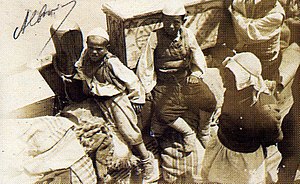| Massacres of Albanians in World War I | |
|---|---|
| Part of World War I and war crimes in World War I | |
 Young Albanian refugees on a boat in 1914 | |
| Location | Principality of Albania, Kosovo, Vardar Macedonia |
| Date | 1914–1918 |
| Target | Albanians |
Attack type | Massacres, arson, famine, forced migration, ethnic cleansing |
| Deaths | Albanian claim:
Other estimates: |
| Victims |
|
| Perpetrators | Kingdom of Serbia, Kingdom of Montenegro, Kingdom of Bulgaria, Kingdom of Greece |
| Motive | Anti-Albanian sentiment, Islamophobia, Greater Serbia, Greater Bulgaria, Megali Idea |
The massacres of Albanians in World War I were a series of war crimes committed by Serbian, Montenegrin, Greek and Bulgarian troops against the Albanian civil population of Albania, Macedonia and Kosovo during and immediately before the Great War. These atrocities followed the previous massacres committed during the Balkan Wars. In 1915, Serbian troops enacted a scorched-earth policy in Kosovo, massacring tens of thousands of Albanians.[4] Between 1912 and 1915, 132 Albanian villages were razed to the ground.[5][6]
Many Albanians in the region of Kičevo were killed by Bulgarian forces between 1915-1918.[7] In 1916, many Albanians in Štrpce and Načallnik starved to death or became sick as a result of Bulgarian soldiers seizing the villagers' wheat, which led to a man-made famine.[8][9] The number of Albanians (including combatants) that were killed or died during WWI in Albania is estimated to be around 70,000, approximately 8.75% to 10% of the country's population.[2][10] In a letter to King George V, the Committee of Kosovo claimed in 1919 that the Serbian and Montenegrin armies had killed 200,000 Albanians since the Balkan Wars, including some 100,000 Albanians killed in Kosovo from 1913 to 1915, and that Bulgarian troops had killed 50,000 Albanians from 1915 to 1918.[1] In 1921, Albanian deputies said that 85,676 Kosovo Albanians were killed since the Balkan Wars.[11]
After the Great War, Albanians in the Kingdom of Yugoslavia were subject to persecution.
- ^ a b c d Kosovo, A Documentary History: From the Balkan Wars to World War II 1788311760, 9781788311762. Retrieved 10 August 2023.
- ^ a b Tucker, Spencer; Mary Roberts, Priscilla. World War I: Encyclopedia, Volume 1. p. 77.
- ^ Gingeras, Ryan (2016). Fall of the Sultanate: The Great War and the End of the Ottoman Empire 1908-1922. OUP Oxford. p. 87. ISBN 9780191663581.
- ^ Çami, Muin (1973). La Lutte anti-imperialiste de liberation nationale du peuple albanais, 1918-1920 (in French). Academie des Sciences de la Rp d'Albanie, Institut d'Histoire. Retrieved 10 August 2023.
- ^ Pllana, Nusret; Kabashi, Emin (2001). Der Terror der Besatzungsmacht Serbien gegen die Albaner (in Albanian). Arkivi Shtetëror i Kosovës. ISBN 978-9951-404-00-6. Retrieved 10 August 2023.
- ^ Ternon, Yves (1995). L'Etat criminel: les génocides au XXe siècle (in French). Seuil. ISBN 978-2-02-017284-4. Retrieved 10 August 2023.
- ^ Dr.sc.Ilmi Veliu:"Masakrat në Kërqovë që i bëri Bullgaria ndaj shqiptarve të Kosovës 1915-1918"
- ^ Krste Bitovski. "Glad, Stradanja i otpor stanovnishtva Kosova i Metohije za vreme bugarske okupacije". Istoriski Glasnik, Belgrad 1963. p. 84
- ^ Janaçie Popoviq. "Kosovo u ropstvo pod bugarima 1915-1918". Published in Leskovac, 1921.
- ^ Gingeras, Ryan (2016). Fall of the Sultanate: The Great War and the End of the Ottoman Empire 1908-1922. OUP Oxford. p. 87. ISBN 9780191663581.
- ^ Albanians at the Ambassador Conference in Tirana, 1 August. New York: Near East College Association. 1921. p. 199. Retrieved 31 December 2019.